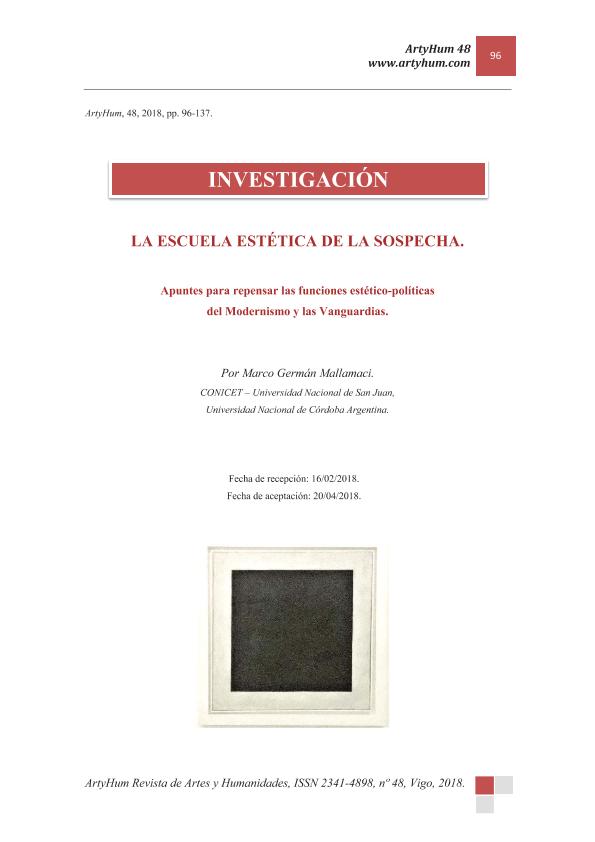Artículo
Los programas políticos del arte occidental de comienzos del siglo XX han sido definidos desde la abstracción y la transformación del sistema figurativo de representación. De allí la idea de que el arte contemporáneo es heredero de las Vanguardias. La discusión (siempre vigente) de hasta dónde aquellos proyectos lograron sus metas o hasta dónde fueron funcionales al sistema que criticaban, confirma la potencia inagotable de aquel periodo. Lo cierto es que, a partir de dichas experiencias, el arte se acercó cada vez más a la forma de un problema. Este trabajo propone repensar las Vanguardias desde la figura de la “escuela de la sospecha”; concepto con el cual Ricoeur englobó los trabajos de Marx, Nietzsche y Freud, mostrándolos como el gozne entre la Modernidad y la hermenéutica contemporánea. El planteo es que, las Vanguardias pueden ser pensadas como una “escuela estética de la sospecha”. Esta transposición de la categoría de Ricoeur hacia el campo estético surge de la pregunta en torno a cómo y cuándo el arte toma la forma de un problema. Al sistematizar las pautas formales y técnicas de cada movimiento, se hizo evidente cómo desde Courbet hasta Duchamp aparecen ciertos elementos de la filosofía de Marx, Nietzsche y Freud; no desde la representación sino en tanto prácticas estético-políticas. De allí el planteo de la “escuela estética de la sospecha” como posible relectura de las Vanguardias. En primer lugar, se expone un repaso de los análisis clásicos sobre las Vanguardias y se sintetiza la figura de la “escuela de la sospecha”. Luego, se plantea un resumen de los elementos estéticopolíticos que explican los quiebres del arte en el comienzo del siglo XX. Finalmente, se propone la figura de la “escuela estética de la sospecha”. The political programs of Western art in the early 20th century have been defined from the abstraction and the transformation of the figurative system of representation. Hence the idea that contemporary art is the heritor of the Avant-garde. The discussion about if those projects achieved their aims or if they were functional to the system they criticized, confirms the power of that period. The truth is that, from these experiences, the art came closer to the shape of a problem. This paper proposes to think the Avant-garde using the figure of the “school of suspicion”; with this concept Ricoeur encompassed the works of Marx, Nietzsche and Freud, presenting them as the hinge from Modernity towards contemporary hermeneutics. The proposal is that the Avant-garde can be thought as an “aesthetic school of suspicion”. This transposition of Ricoeur's category into the aesthetic field arises from the question about how and when art takes the shape of a problem. By systematizing the technics and forms of each movement, it became evident that, from Courbet to Duchamp, appear certain elements of the philosophy of Marx, Nietzsche and Freud; not from representation but as aesthetic-political practices. Hence the proposal of the “aesthetic school of suspicion” as a possible reformulation of the Avant-garde. First, it is exposed a review of the classic analyzes of the Avant-garde and synthesized the figure of the “school of the suspicion”. Then are analyzed a summary of the aesthetic-political elements that explain the ruptures of art in the early 20th century. Finally, is proposed the figure of the “aesthetic school of suspicion”.
La escuela estética de la sospecha: apuntes para repensar las funciones estético-políticas del Modernismo y las Vanguardias
Fecha de publicación:
05/2018
Editorial:
ArtyHum
Revista:
ArtyHum
ISSN:
2341-4898
Idioma:
Español
Tipo de recurso:
Artículo publicado
Clasificación temática:
Resumen
Palabras clave:
ESCUELA DE LA SOSPECHA
,
VANGUARDIAS
,
ESTÉTICA
,
POLÍTICA
,
ARTE
,
SOCIEDAD
Archivos asociados
Licencia
Identificadores
Colecciones
Articulos(CCT - SAN JUAN)
Articulos de CENTRO CIENTIFICO TECNOLOGICO CONICET - SAN JUAN
Articulos de CENTRO CIENTIFICO TECNOLOGICO CONICET - SAN JUAN
Citación
Mallamaci, Marco German; La escuela estética de la sospecha: apuntes para repensar las funciones estético-políticas del Modernismo y las Vanguardias; ArtyHum; ArtyHum; 48; 5-2018; 96-137
Compartir




